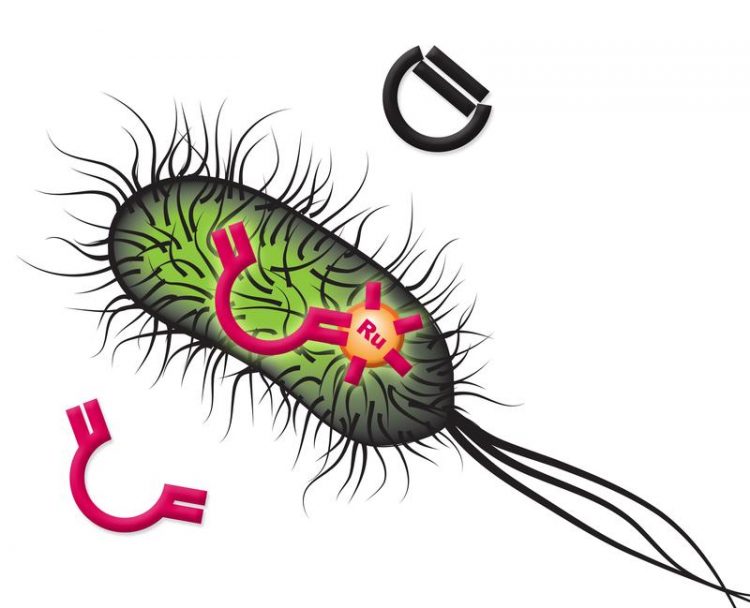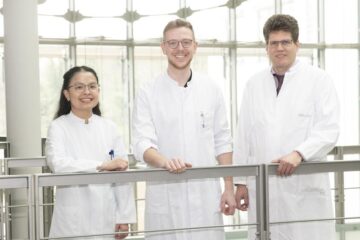Bringing artificial enzymes closer to nature

Representation of the new-to-nature olefin metathesis reaction in E. coli using a ruthenium-based artificial metalloenzyme to produce novel high added-value chemicals. Image: NCCR Molecular Systems Engineering
The artificial metalloenzyme, termed biot-Ru–SAV, was created using the biotin–streptavidin technology. This method relies on the high affinity of the protein streptavidin for the vitamin biotin, where compounds bound to biotin can be introduced into the protein to generate artificial enzymes.
In this study the authors introduced an organometallic compound, with the metal ruthenium at its base. Organometallic compounds are molecules containing at least one bond between a metal and a carbon atom, and are often used as catalysts in industrial chemical reactions. However, organometallic catalysts perform poorly, if at all, in aqueous solutions or cellular-like environments, and need to be incorporated into protein scaffolds like streptavidin to overcome these limitations.
“The goal was to create an artificial metalloenzyme that can catalyse olefin metathesis, a reaction mechanism that is not present among natural enzymes,” says Thomas R Ward, Professor at the Department of Chemistry, University of Basel, and senior author of the study. The olefin metathesis reaction is a method for the formation and redistribution of carbon-carbon double bonds widely used in laboratory research and large-scale industrial productions of various chemical products. Biot-Ru–SAV catalyses a ring-closing metathesis to produce a fluorescent molecule for easy detection and quantification.
Periplasm as reaction compartment
However, the environment inside a living cell is far from ideal for the proper functioning of organometallic-based enzymes. “The main breakthrough was the idea to use the periplasm of Escherichia coli as a reaction compartment, whose environment is much better suited for an olefin metathesis catalyst,” says Markus Jeschek, a researcher from the team of co-supervising author Sven Panke at the Department of Biosystems Science and Engineering, ETH Zurich in Basel. The periplasm, the space between the inner cytoplasmic membrane and the bacterial outer membrane in gram-negative bacteria, contains low concentrations of metalloenzymes inhibitors, such as glutathione.
Having found ideal in vivo conditions, the authors went a step forward and decided to optimize biot-Ru–SAV by applying principles of directed evolution, a method that mimics the process of natural selection to evolve proteins with enhanced properties or activities. “We could then develop a simple and robust screening method that allowed us to test thousands of biot-Ru–SAV mutants and identify the most active variant,” Ward explains.
Not only could the authors markedly improve the catalytic properties of biot-Ru–SAV, but they could also show that organometallic-based enzymes can be engineered and optimized for different substrates, thus producing a variety of different chemical products. “The exciting thing about this is that artificial metalloenzymes like biot-Ru–SAV can be used to produce novel high added-value chemicals,” Ward says. “It has a lot of potential to combine both chemical and biological tools to ultimately utilize cells as molecular factories.”
Original source
Markus Jeschek, Raphael Reuter, Tillmann Heinisch, Christian Trindler, Juliane Klehr, Sven Panke & Thomas R. Ward
Directed evolution of artificial metalloenzymes for in vivo metathesis
Nature (2016), doi: 10.1038/nature19114
Further information
• Prof. Thomas R. Ward, University of Basel, Department of Chemistry, Tel. +41 61 267 10 04, email: thomas.ward@unibas.ch
• Prof. Sven Panke, ETH Zurich, Department of Biosystems Science and Engineering, Tel. +41 61 387 32 09, email: sven.panke@bsse.ethz.ch
Media Contact
More Information:
http://www.unibas.chAll latest news from the category: Life Sciences and Chemistry
Articles and reports from the Life Sciences and chemistry area deal with applied and basic research into modern biology, chemistry and human medicine.
Valuable information can be found on a range of life sciences fields including bacteriology, biochemistry, bionics, bioinformatics, biophysics, biotechnology, genetics, geobotany, human biology, marine biology, microbiology, molecular biology, cellular biology, zoology, bioinorganic chemistry, microchemistry and environmental chemistry.
Newest articles

Airborne single-photon lidar system achieves high-resolution 3D imaging
Compact, low-power system opens doors for photon-efficient drone and satellite-based environmental monitoring and mapping. Researchers have developed a compact and lightweight single-photon airborne lidar system that can acquire high-resolution 3D…

Simplified diagnosis of rare eye diseases
Uveitis experts provide an overview of an underestimated imaging technique. Uveitis is a rare inflammatory eye disease. Posterior and panuveitis in particular are associated with a poor prognosis and a…

Targeted use of enfortumab vedotin for the treatment of advanced urothelial carcinoma
New study identifies NECTIN4 amplification as a promising biomarker – Under the leadership of PD Dr. Niklas Klümper, Assistant Physician at the Department of Urology at the University Hospital Bonn…





















